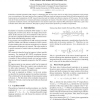Free Online Productivity Tools
i2Speak
i2Symbol
i2OCR
iTex2Img
iWeb2Print
iWeb2Shot
i2Type
iPdf2Split
iPdf2Merge
i2Bopomofo
i2Arabic
i2Style
i2Image
i2PDF
iLatex2Rtf
Sci2ools
LREC
2008
2008
Automatic Evaluation Measures for Statistical Machine Translation System Optimization
Evaluation of machine translation (MT) output is a challenging task. In most cases, there is no single correct translation. In the extreme case, two translations of the same input can have completely different words and sentence structure while still both being perfectly valid. Large projects and competitions for MT research raised the need for reliable and efficient evaluation of MT systems. For the funding side, the obvious motivation is to measure performance and progress of research. This often results in a specific measure or metric taken as primarily evaluation criterion. Do improvements in one measure really lead to improved MT performance? How does a gain in one evaluation metric affect other measures? This paper is going to answer these questions by a number of experiments.
| Added | 29 Oct 2010 |
| Updated | 29 Oct 2010 |
| Type | Conference |
| Year | 2008 |
| Where | LREC |
| Authors | Arne Mauser, Sasa Hasan, Hermann Ney |
Comments (0)

